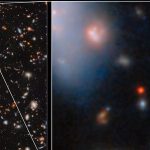Researchers using the NASA/ESA/CSA James Webb Space Telescope have confirmed an actively growing supermassive black hole within a galaxy just 570 million years after the Big Bang. Part of a class of small, very distant galaxies that have mystified astronomers, CANUCS-LRD-z8.6 represents a vital piece of this puzzle that challenges existing theories about the formation of galaxies and black holes in the early Universe. The discovery connects early black holes with the luminous quasars we observe today.
Rome, Nov 19, 2025.- Over its first three years, Webb’s surveys of the early Universe have turned up an increasing number of small, extremely distant, and strikingly red objects. These so-called Little Red Dots (LRDs) remain a tantalising mystery to astronomers, despite their unexpected abundance. The discovery in CANUCS-LRD-z8.6, made possible by Webb’s exceptional capabilities, has assisted in this hunt for answers. Webb’s Near-Infrared Spectrograph (NIRSpec) enabled researchers to observe the faint light from this distant galaxy and detect key spectral features that point to the presence of an accreting black hole.
Roberta Tripodi, lead author of the study and a researcher of the University of Ljubljana FMF, in Slovenia and INAF – Osservatorio Astronomico di Roma, in Italy, explained: «This discovery is truly remarkable. We’ve observed a galaxy from less than 600 million years after the Big Bang, and not only is it hosting a supermassive black hole, but the black hole is growing rapidly – far faster than we would expect in such a galaxy at this early time. This challenges our understanding of black hole and galaxy formation in the early Universe and opens up new avenues of research into how these objects came to be.»
The team analysed the galaxy’s spectrum, which showed gas which had been highly ionised by energetic radiation, and suggested it was rotating quickly around a central source. These features are key characteristics of an accreting supermassive black hole. The precise spectral data yielded an estimate of the black hole’s mass, revealing it to be unusually large for such an early stage in the Universe, and showed that CANUCS-LRD-z8.6 is compact and has not yet produced many heavy elements — a galaxy at an early stage of its evolution. This combination makes it an intriguing subject for study.
Additionally, the Webb spectroscopy allowed the team to measure how much energy is emitted at different wavelengths, from which they were able to characterise the galaxy’s physical properties. This allowed them to determine the mass of the galaxy’s stars and compare it with the black hole’s mass. «The data we received from Webb was absolutely crucial,” added Dr. Nicholas Martis, a collaborator from the University of Ljubljana, FMF, who helped analyse the spectrum of the source. “The spectral features revealed by Webb provided clear signs of an accreting black hole at the centre of the galaxy, something that could not have been observed with previous technology. What makes this even more compelling is that the galaxy’s black hole is overmassive compared to its stellar mass. This suggests that black holes in the early Universe may have grown much faster than the galaxies that host them.»
Astronomers have previously observed that the mass of a supermassive black hole and its host galaxy are linked: the larger a galaxy grows, the larger its central black hole also becomes. CANUCS-LRD-z8.6 is the most massive host galaxy known at such an early time, yet its central black hole is even more massive than we would expect, defying the usual relation. The result suggests that black holes may have formed and started growing at an accelerated pace in the early Universe, even in relatively small galaxies.
«This discovery is an exciting step in understanding the formation of the first supermassive black holes in the Universe,” explained Prof. Maruša Bradač, leader of the group at the University of Ljubljana, FMF. “The unexpected rapid growth of the black hole in this galaxy raises questions about the processes that allowed such massive objects to emerge so early. As we continue to analyse the data, we hope to find more galaxies like CANUCS-LRD-z8.6, which could provide us with even greater insights into the origins of black holes and galaxies.»
The team is already planning additional observations with the Atacama Large Millimetre/submillimetre Array (ALMA) and Webb to further study the cold gas and dust in the galaxy and to refine their understanding of the black hole’s properties. The ongoing research into this LRD is poised to answer crucial questions about the early Universe, including how black holes and galaxies co-evolved in the first billion years of cosmic history.
As astronomers continue to explore the early Universe with JWST, further surprises are expected to emerge, offering an increasingly detailed picture of how the first supermassive black holes grew and evolved, setting the stage for the formation of the luminous quasars that light up the Universe today.
The results were obtained by the CANUCS collaboration from the Webb observing programme #1208 (PI: C. J. Willott) and have been published today in Nature Communications.
More information
Webb is the largest, most powerful telescope ever launched into space. Under an international collaboration agreement, ESA provided the telescope’s launch service, using the Ariane 5 launch vehicle. Working with partners, ESA was responsible for the development and qualification of Ariane 5 adaptations for the Webb mission and for the procurement of the launch service by Arianespace. ESA also provided the workhorse spectrograph NIRSpec and 50% of the mid-infrared instrument MIRI, which was designed and built by a consortium of nationally funded European Institutes (The MIRI European Consortium) in partnership with JPL and the University of Arizona.
Webb is an international partnership between NASA, ESA and the Canadian Space Agency (CSA).
Image Credit: ESA/Webb, NASA & CSA, G. Rihtaršič (University of Ljubljana, FMF), R. Tripodi (University of Ljubljana, FMF)










